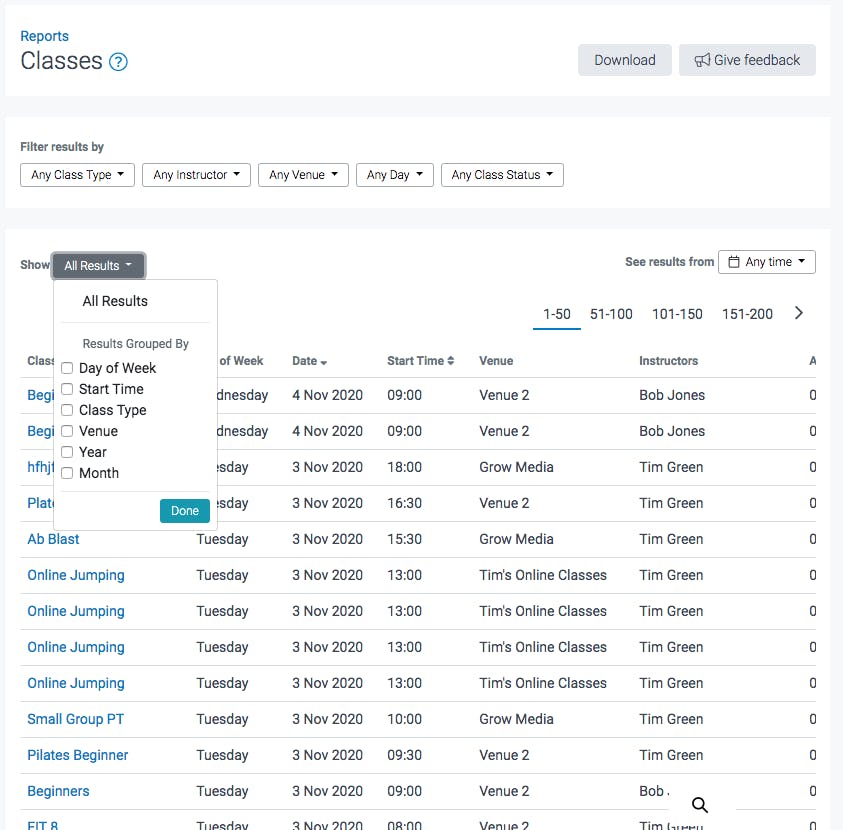This article is for fitness business owners who want to sincerely help people enjoy fitness. In order to run a customer-centric (i.e. super successful) business, you have to get to know what your customers want. But, how can you do that?
Business owners learn from their customers by listening to 'data.'
Once you have data, you can make deliberate business decisions with confidence. Imagine what you could do with information like this: "My favourite class starts at 6 but I get out of work at 5:45, so I can never make it. If the class started at 6:15 that would give me time to leave work and make it to the class on time." You would know to change class times to 6:15 to boost attendance.
Other changes you can make with data:
- Determining classes that are unpopular and cutting them from the schedule. Maybe you need to get rid of the midday class because on average, only two people are showing up.
- Comparing which classes are more popular than other. In Yoga for example, some businesses offer more traditional flow in some classes and also yoga sculpt in others. Figuring out with insights what classes are more popular can help you optimise your time slots.
- Identify which instructors are the most popular while accounting for time slots and class content.

How to get data from your customers
There are two ways to get data from your customers. Either you look at their behaviour, or you ask them directly. The strongest businesses will do both, in this order:
- Look at your data first. Identify the weak spots your schedule might have. Do this with the Classes Report in the TeamUp dashboard.
- Send out a survey to your customers about how different classes could change.
- Interview specific customers about their daily schedules, and what might be holding them back from attending specific classes.
One of the best times to connect with customers about what they want from you is just after you've identified the things you think need changing. Maybe a class time isn't working, or a type of class is becoming less popular. Once you identify specifics, you can go to your customers with a better idea of what questions you need them to answer.
How to identify business problems the Classes Report
The types of problems you are looking for are the types of problems that affect your customers. Does the 18:00 class time not give enough time for customers to get there after work? Does the noon class not set the right pace? You won't know unless you first look at your data to find out what classes are busy, and which ones are lagging.
One of the most powerful way to identify problems in your class schedule is via the Classes Report in your dashboard. The Classes Report can tell you a lot about how customers are responding to your schedule:
- What are your best performing days, start times, class types, venues, and months for attendance?
- What is your average attendance by year?
- Who are your best performing instructor by attendance?
- What is the difference in average attendance by venue?
- What time slots are full and where might you need to add more classes?
- Who is attending each class?
- All of the above filtered by any date range
The Classes report looks like this. You can organise by class type, instructor, venue, day, or class status, and by date range.

How to survey your customers
Once you have an idea of what you'd like to learn more about, you can contact your customers with surveys or with interviews. If you are surveying for a specific time slot, you could ask your customers:
The 7:30am class on Wednesdays is not very popular. Would you be more likely to attend at any of the following times?
- 7:00
- 7:15
- 7:45
- 8:00
- 8:15
- I would not attend a Wednesday morning class
Please tell us more about what might be blocking you from attending this class: ______
- I don't like morning classes
- I don't have time in the morning
- I'm too tired to workout at this time
- The class isn't quite right for me
- Another reason ____
I would be more likely to attend this class if ___ changed?
- The type of class
- The instructor
- The music
- The equipment
- Nothing needs to change, this time just isn't for me.
How to interview customers
If you want to get a fuller picture of why certain classes aren't as popular, you can ask customers directly what their schedules are like, and what classes would be most beneficial to them. You can ask questions like:
- I've noticed you attend classes in the afternoon. How do these classes fit with your weekly schedule?
- Sometimes you attend classes in the morning, but it's not a weekly thing. What's your schedule like in the mornings?
- What classes do you like best? What is it about those classes that you like?
- Is there a class time that you wish we offered?
- Is there a class type that you wish we offered more of?
Once you start the conversation you want to have, it should be easy to ask follow up questions. Don't think of it like an interview. You're just trying to get to know them better.
Make decisions with data
In our day-to-day lives, it's easy to build impressions of how something could improve. But report numbers can show you a truer, bigger picture analysis. If you want to listen to your customers in a meaningful way, start with the Classes Report, then send out a survey and/or interview a few key members.
Making key business decisions about class times, class types, and instructors impact your customers directly. Why wouldn't you ask them about what they want?